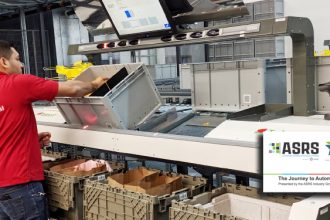The Do’s and Don’ts of ASRS

Get your plans in order before implementing a new ASRS.
One of the best space-saving and productivity-boosting pieces of automation is the automated storage and retrieval system (ASRS). Designed to automatically place materials into storage and/or retrieve them for order fulfillment, ASRS replaces manual warehousing tasks. It can save on labor costs, provide space savings on your warehousing floor, and boost productivity. It also minimizes errors by taking humans out of the equation.
However, before implementing an ASRS, carefully consider a few things to do and not do.
Do:
- Think of high-density storage — when considering ASRS. One of the biggest benefits to ASRS is its ability to utilize the cube without wasting available space in the facility. You’ll be able to store and retrieve products much higher than you would without the system in place. Using software like a warehouse management system (WMS) and warehouse execution software (WES), combined with cranes, conveyors, and shuttles, you’ll have built-in high density.
- Operate safely—With an ASRS in place, you’ll remove humans from the equation because you’ll minimize the need for manual materials handling. This frees your employees to perform more value-added services and avoid potential injury.
- Boost your accuracy—Humans performing manual labor can make mistakes. ASRS removes that propensity from the equation, boosting accuracy rates across the board.
- Increase your productivity—When an ASRS is in charge of storage and retrieval, you’ll boost your turnaround times, becoming smoother, faster, and more efficient.
- Reduce labor—With the ongoing labor shortage, perhaps the biggest do from an ASRS implementation is labor reduction. Automation will allow you to do more work with fewer people.
Don’t:
- Get hung up on the initial cost—An investment in an ASRS doesn’t come inexpensively, but you need to account for all the long-term benefits you’ll achieve by adding a system. Beyond reduced labor costs, you’ll save many other expenses over the lifetime of an ASRS, making it worth the price tag.
- Overlook the need for skilled maintenance—An ASRS requires talented, skilled labor personnel to keep it operational. Make sure you’ve got someone on staff who can prevent downtime by maintaining upkeep.
- Forget to plan ahead—While highly beneficial, ASRS isn’t the most flexible type of material handling system you can add to your warehousing floor. Think through the loads you’d like your system to handle and plan ahead for them. Before investing, make sure it’s suitable for changes and your long-term goals.
- Overlook the contingencies—ASRS is automation, and therefore, it is subject to occasional downtime and breakdowns. Think through your contingency plans in advance.
- Forget you need trained labor—You’ll need competent, tech-savvy staff to work with an ASRS, so make sure you have that skilled labor available on every shift.
An ASRS can serve as the cornerstone of any material handling automation. While it won’t replace your staff, it will supplement and protect them, leading to productivity gains.
Source: Jason Stahl, Murata Machinery USA/Muratec
For more information about the AS/RS group: mhi.org/as-rs
For further articles from the Automated Storage/Retrieval Systems (AS/RS):
Adding Robots to the Cold Chain
March 4 MHI Tech Talk Explores Integrating Racks With Automation
Is a VLM Right for Your Operations?
Understanding ASRS Software Integration
ASRS Is Perfect For Social Distancing
Podcast: How Does An ASRS Solution Differ And Complement AMRs/AGVs?
ASRS As A Solution To The Labor Shortage



